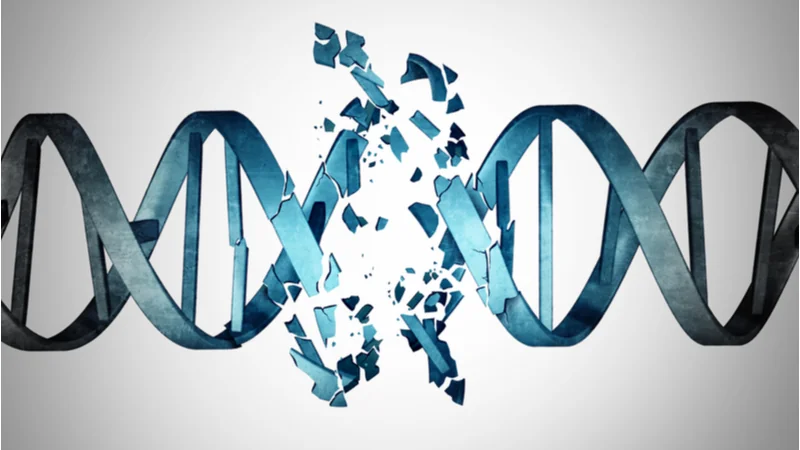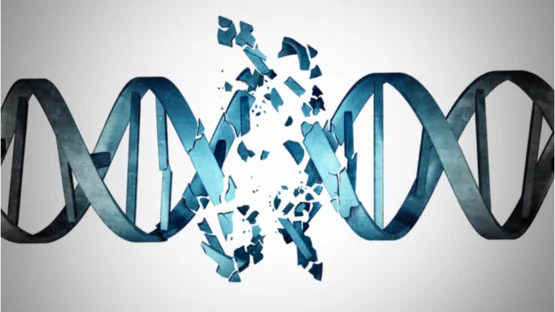A review published in Frontiers in Cell and Developmental Biology has explained how DNA damage and its accompanying immune response lead to changes in the microenvironment of stem cells, causing a decline in their function.
A direct relationship
After an introduction, the reviewers begin their discussion by talking about direct DNA damage and its accompanying repair response. They explain that DNA damage can be caused by exogenous (outside the body) sources, such as UV rays and X rays. However, this damage can also be caused by endogenous (inside the body) sources, such as telomere attrition, advanced glycation end-products (AGEs), replication stress, and reactive oxygen species caused by mitochondrial dysfunction. These sources are known to increase with age [1].
Because each cell might be exposed to 100,000 DNA lesions every day [2], we have evolved a wide variety of repair mechanisms to offset this damage, which are collectively known as the DNA damage response. Single-strand breaks, nucleotide excisions that distort the helix, and double-strand breaks all have individual repair mechanisms. However, when the damage is too much, cells can die off through apoptosis or become senescent, ceasing to divide [3].
Direct stem cell aging through this genomic instability leads to systemic and potentially deadly problems, such as tissue degeneration and cancer [4]. The reviewers list a very large number of diseases that are caused by this direct relationship, but of interest here is what this does to the microenvironment.
Immune system activation
The researchers note that immune systems can be activated by both pathogen-associated molecular patterns (PAMPs) and damage-associated molecular patterns (DAMPs). The receptors for recognizing these molecules are very similar, and they lead to similar immune responses, the goal of which is to summon other immune cells to the area and ultimately remove the harmful elements [5].
One of the activators of this response is DNA itself. If DNA is released into cells from the mitochondria or nucleus, which can be caused by a ruptured nuclear lamina (as occurs in progeria and aging), this activates specific DNA sensors that turn on the DAMP immune response [6].
Another problem is that latent endogenous retroviruses, which are sequences that had infected our ancestors’ cells millions of years ago, can be activated upon DNA damage. Once activated, these sequences cause accompanying immune activation in response [7].
Inflammatory responses, which are meant to alleviate short-term infections, instead harm the function of stem cells in the long term, including the bone marrow [8]. This counterproductive activity, which also occurs in other age-related contexts, is the fundamental feature of inflammaging, the growing inflammation associated with aging.
This review goes into exacting detail as to the biochemical pathways involved in this response, including the DNA-sensing enzyme cGAS, the interferon gene stimulator STING, and its relationship to various inflammatory factors, including cytokines and interleukins.
Cellular senescence

Read More
The reviewers also discuss cellular senescence, particularly the senescence-associated secretory phenotype (SASP). Interestingly, their view of the SASP, which varies between cells, is not entirely negative. While the reviewers do point out that the SASP is strongly linked to inflammation and can cause cancer, depending on context [9], they also note a study stating that SASP factors, when administered for limited amounts of time, can actually promote healthy tissue regeneration [10].
In fact, in one study that is likely to amaze our regular readers, it has been shown that the senescence marker p16INK4a and the SASP component IL-6 promote in vivo cellular reprogramming through OSKM [11]!
Conclusion
While this review goes into deep detail regarding the intertwined nature of stem cells and inflammation, its reviewers hold that the fundamental problem is simple. What we want medicine to do, in this case, is to harness the power of immune cells to fight cancer and tumors while suppressing their negative effects on healthy stem cell growth and proliferation.
Obviously, this is a tall order and will require an enormous amount of work. DNA damage to stem cells and the associated deterioration of the microenvironment are a significant challenge for many reasons. However, if we are truly going to wipe away age-related diseases, it is a challenge that researchers must one day tackle.
Literature
[1] Schumacher, B., Pothof, J., Vijg, J., & Hoeijmakers, J. H. (2021). The central role of DNA damage in the ageing process. Nature, 592(7856), 695-703.
[2] Madabhushi, R., Pan, L., & Tsai, L. H. (2014). DNA damage and its links to neurodegeneration. Neuron, 83(2), 266-282.
[3] Jackson, S. P., & Bartek, J. (2009). The DNA-damage response in human biology and disease. Nature, 461(7267), 1071-1078.
[4] Behrens, A., Van Deursen, J. M., Rudolph, K. L., & Schumacher, B. (2014). Impact of genomic damage and ageing on stem cell function. Nature cell biology, 16(3), 201-207.
[5] Gasteiger, G., D’osualdo, A., Schubert, D. A., Weber, A., Bruscia, E. M., & Hartl, D. (2017). Cellular innate immunity: an old game with new players. Journal of innate immunity, 9(2), 111-125.
[6] Mackenzie, K. J., Carroll, P., Martin, C. A., Murina, O., Fluteau, A., Simpson, D. J., … & Jackson, A. P. (2017). cGAS surveillance of micronuclei links genome instability to innate immunity. Nature, 548(7668), 461-465.
[7] Lee, A. K., Pan, D., Bao, X., Hu, M., Li, F., & Li, C. Y. (2020). Endogenous retrovirus activation as a key mechanism of anti-tumor immune response in radiotherapy. Radiation research, 193(4), 305-317.
[8] Hormaechea-Agulla, D., Le, D. T., & King, K. Y. (2020). Common sources of inflammation and their impact on hematopoietic stem cell biology. Current Stem Cell Reports, 1-12.
[9] Faget, D. V., Ren, Q., & Stewart, S. A. (2019). Unmasking senescence: context-dependent effects of SASP in cancer. Nature Reviews Cancer, 19(8), 439-453.
[10] Ritschka, B., Storer, M., Mas, A., Heinzmann, F., Ortells, M. C., Morton, J. P., … & Keyes, W. M. (2017). The senescence-associated secretory phenotype induces cellular plasticity and tissue regeneration. Genes & development, 31(2), 172-183.
[11] Mosteiro, L., Pantoja, C., de Martino, A., & Serrano, M. (2018). Senescence promotes in vivo reprogramming through p16 INK 4a and IL-6. Aging cell, 17(2), e12711.





